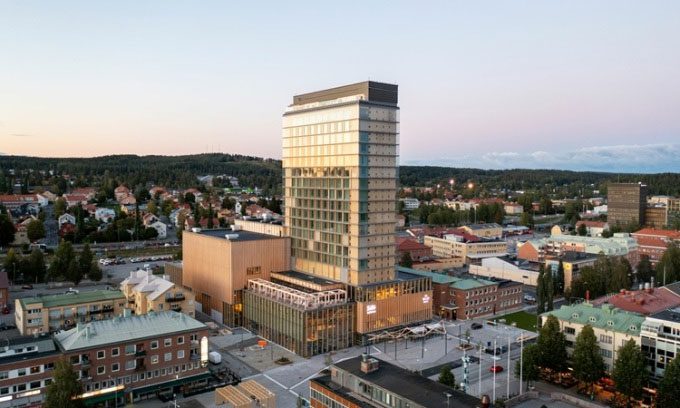Swedish engineers are exploring ways to go back to the era before the advent of bricks and reinforced concrete, thereby constructing impressive skyscrapers made of wood.
The shift to glued laminated timber brings sustainability to the construction industry. Contractors have just completed a project demonstrating this concept, named the Sara Cultural Center, valued at $110 million in Skellefteå, Sweden, as reported by Business Insider on November 1. According to Robert Schmitz, the chief architect at White Arkitekter, the firm behind the project, they aim to create a “bold building.” Almost every component of the Sara Center is constructed from prefabricated wood. The complex features expansive halls and wide-open views. Visitors to the center can utilize the public library, a banquet hall, and three theaters.

The Sara Cultural Center is largely constructed from wood. (Photo: White Arkitekter).
According to engineers, at least in the densely forested areas of Sweden, wooden structures are the future of sustainable buildings for several reasons. Such buildings do not rely on concrete. The emissions associated with construction materials are becoming a larger source of carbon dioxide than most other factors due to increasing demand and production scale. The cement industry accounts for about 8% of global CO2 emissions, according to research from the University of Rochester. Wooden buildings also do not depend on steel, a material that contributes to approximately 7 – 9% of CO2 emissions worldwide.
White Arkitekter states that their construction process is carbon-neutral, as the building itself will store nearly 9,100 tons of CO2, enough to offset the carbon emissions from transporting and constructing the project. Additionally, the engineers at the Sara Center ensure the building’s safety by using fire-resistant coatings.
Glued laminated timber is a wood product made from small-sized solid wood pieces (lamellas) glued together. It is formed from at least four strips or sheets of sawn timber, with a maximum thickness of 30, 45, or 60 mm, with the grain direction running along the length of the product.
The trend of building with wood is not limited to Sweden. Currently, across Europe, Asia, and the United States, wood is becoming an increasingly popular construction material, partly due to the need to address climate change. The U.S. is also beginning to consider wooden structures as it enacts building regulations. According to Reuters, the use of glued laminated timber in the U.S. could significantly increase in the future.





















































